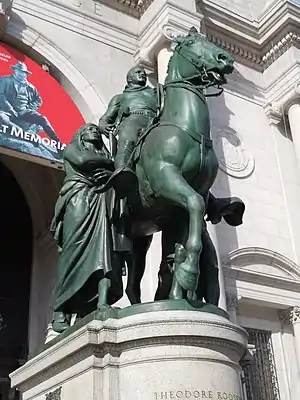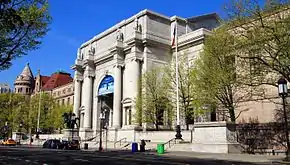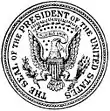Equestrian Statue of Theodore Roosevelt (New York City)
Equestrian Statue of Theodore Roosevelt is a 1939 bronze sculpture by James Earle Fraser.[1] It is located on public park land at the American Museum of Natural History, New York City. The equestrian statue depicts Theodore Roosevelt on horseback. Walking on either side of him are two men, one an indigenous person and one an African.
| Equestrian Statue of Theodore Roosevelt | |
|---|---|
 | |
| Artist | James Earle Fraser |
| Year | 1939 |
| Type | Bronze |
| Dimensions | 300 cm × 218 cm × 450 cm (10 ft × 7 ft 2 in × 14 ft 9 in) |
| Location | Manhattan, United States |
| 40°46′51.01″N 73°58′22.21″W | |
On June 21, 2020, the Museum announced that it was asking city officials to remove the statue. Museum president Ellen V. Futter said the decision did not reflect a judgment about Roosevelt but was driven by the sculpture's "hierarchical composition".[2] New York Mayor Bill de Blasio, pushed for it and it was supported by Roosevelt's great-grandson, Theodore Roosevelt IV, and great-great-grandson Kermit Roosevelt III.[3]
History
It was dedicated on October 27, 1940. Cast by Gorham Manufacturing Company, Providence, RI.
The inscription reads:
(On rear of sculpture:)
J E FRASER SC 1939
(On front of base:)
THEODORE ROOSEVELT
1858–1919
(On left side of base:)
GOVERNOR OF THE STATE OF NEW YORK
1899 1901
(On right side of base:)
PRESIDENT OF THE UNITED STATES
1901 1909 signed
Commission

The sculpture was commissioned by the Roosevelt Memorial Association in the 1930s after Fraser had delivered his design for the Arts of Peace memorial in Washington D.C., which at the time was also in competition with this memorial as the chosen location. For Arts of Peace, Fraser made a pair of statues of Pegasus depicting the themes Music and Harvest, and Aspiration and Literature.[4]
The statue is placed at the entrance to the Museum's hall of dioramas dedicated to Carl Akeley who had accompanied Roosevelt on a year-long expedition to Africa. The sculpture and its pedestal were designed for this setting, appropriate in scale and design for the neo-classical plans of Henry Bacon's architecture. An earlier monument by Fraser dedicated to Roosevelt in Cuba in 1924 was also designed with Henry Bacon, and they both attended its dedication in Cuba.[5]
The two walking figures have been construed as representations of continents, not individuals in a narrative, and that was common practice in public sculpture, of which London's Albert Memorial is a prominent example. At the same time, the "pyramidal composition" with Roosevelt at its apex "implies a hierarchy". One analysis of the work, after examining the careers of both Roosevelt and Fraser, concludes that "Both men evidently believed in white dominance as natural order. However, Roosevelt and Fraser also had sincere, if paternalistic, admiration for indigenous cultures and a desire to preserve images and artifacts in what was, for the time, a relatively respectful manner."[6] As an early champion of civil rights and equality for black and Native Americans during the early 20th century, many feel the statue depicts Roosevelt as leading minority persons in the U.S. forward towards the promises made to all under the U.S. constitution. Roosevelt's relationship with Booker T. Washington and his appointment of Minnie Cox as the first black regional postmaster in the United States (Indianola, MS) is seen as further cementing this view. Roosevelt's own comments regarding race indicated that he believed all the races were equal, but some cultures were superior due to their greater technological advances over time. The sculptor of the statue, James Earle Fraser, stated the intent with these words: “The two figures at [Roosevelt’s] side are guides symbolizing the continents of Africa and America, and if you choose may stand for Roosevelt’s friendliness to all races.”
Controversy
.jpg.webp)
In 1999 James Loewen argued in Lies Across America that the statue was erected when the museum was openly racist, and that the arrangement of the figures is meant to advocate white supremacy.[7]
This statue was not otherwise the subject of public controversy in the 20th century. It was mentioned in the April 2017 TED talk Can Art Amend History? by artist and activist Titus Kaphar, discussing the choice of pose showing that "Teddy Roosevelt is sitting there ...and on the left-hand side of him is a Native American walking and on the right-hand side of him is an African-American walking" as a representation of white social hierarchy in America.[8][9] After the Unite the Right rally due to the controversial removal of an equestrian statue of Robert E. Lee, this and many other statues across America also became the focus of attempts to remove glorifications of America's racist past. The base of the statue was defaced with red paint on the morning of October 26, 2017. A few hours later, a group claiming responsibility stated that the statue embodied "patriarchy, white supremacy, and settler-colonialism."[10]
In January 2018, a commission appointed by New York City Mayor Bill de Blasio to review several statues on city property concluded that this statue was open to many interpretations and made no recommendation for action.[11] The commission's members were divided evenly. Some citing research that the standing figures are allegorical representations of the continents and noting that these figures "are in no way abject". Others emphasized how the sculpture is experienced, "that height is power in public art", an expression of "power and dominance".[12] New York Times critic Holland Cotter found that decision disappointing: "It doesn’t require a sensitivity to subtexts to see that the composition, no matter how you gloss it, is quite literally an emblem of white-man-on-top."[11]
In July 2019, the Museum of Natural History mounted an exhibit devoted to the statue and contemporary interpretations called "Addressing the Statue".[13] The presentation including many contrasting viewpoints and invited comments from visitors. David Hurst Thomas, the curator of anthropology at the Museum said: "The museum is making a really explicit statement that we’re big enough to stand up for our past. We're not going to cover it up. We’re going to welcome dissent."[14] The exhibit included an extensive website for further exploration of the sculpture and its interpretation.[15] It presented comments by the sculptor and his collaborators alongside those of academics who contested what the two walking figures represent and whether Roosevelt could be described as a "racial unified".[16]
To provide context for those viewing the sculpture, the Museum installed laminated placards at its base that said: "This statue was unveiled to the public in 1940, as part of a larger New York State memorial to former N.Y. governor and U.S. President Theodore Roosevelt. Today, some see the statue as a heroic group; others, as a symbol of racial hierarchy. You can learn more about this statue inside the Museum and [online]." They were not visible at a distance and were dwarfed by the monument itself.[6]
Planned removal
The world does not need statues, relics of another age, that reflect neither the values of the person they intend to honor nor the values of equality and justice. — Theodore Roosevelt IV[2]
On June 21, 2020, the Museum announced that it would remove the statue.[17] Museum president Ellen V. Futter said the decision did not reflect a judgment about Roosevelt but was driven by the sculpture's "hierarchical composition".[2] Her statement to Museum staff said that "many of us find its depictions of the Native American and African figures and their placement in the monument racist".[13] Roosevelt's great-grandson, Theodore Roosevelt IV, approved the decision, saying "The world does not need statues, relics of another age, that reflect neither the values of the person they intend to honor nor the values of equality and justice."[2] New York City Mayor Bill de Blasio said: "The American Museum of Natural History has asked to remove the Theodore Roosevelt statue because it explicitly depicts Black and Indigenous people as subjugated and racially inferior. The City supports the Museum’s request. It is the right decision and the right time to remove this problematic statue."[18]
On July 12, 2020, Roosevelt's great-grandson Mark Roosevelt backed efforts to remove the statue, stating in a CBS News article "If we wish to live in harmony and equality with people of other races, we should not maintain paternalistic statues that depict Native Americans and African Americans in subordinate roles. The statue of Theodore Roosevelt, my great-grandfather, in front of New York's Museum of Natural History, does so, and it is good that it is being taken down."[19]
See also
- Allegorical sculpture
- Architectural sculpture
- Monument and memorial controversies in the United States
- Monumental propaganda
- Monumental sculpture
- Theodore Roosevelt, Rough Rider, 1922 equestrian statue in Portland, Oregon
References
- "Equestrian Statue of Theodore Roosevelt, (sculpture)". SIRIS
- Pogrebin, Robin (21 June 2020). "Roosevelt Statue to Be Removed From Museum of Natural History". New York Times. Retrieved 21 June 2020.
- ABC7NY: Why is Theodore Roosevelt's statue being removed from the American Museum of Natural History
- Heth, Jennifer Dawn (2014). "Imagining TR: Commemorations and Representations of Theodore Roosevelt in Twentieth-Century America" (PDF). Texas A&M University; dissertation
- "Dedication of Cuban Memorial, 1924". Roosevelt Memorial Association. [United States: s.n., 1924?] United States.] in the Library of Congress
- Marber, Sinclaire Devereux. "Bloody Foundation? Ethical and Legal Implications of (Not) Removing the Equestrian Statue of Theodore Roosevelt at the American Museum of Natural History". Columbia Journal of Law & the Arts. 43: 94, 102. Retrieved 23 June 2020.
- Loewen, James (1999). Lie Across America: What Our Historic Sites Get Wrong. New York: W. W. Norton & Company, Inc. p. 45. ISBN 1-56584-344-4.
- Titus Kaphar on TED website
- Interview of Kaphar on NPR, which may have been recorded earlier and doesn't mention the vandalism
- Tracy, Thomas (27 October 2017). "Vandals splash red paint on Theodore Roosevelt statue on Museum of Natural History steps". New York Daily News. Retrieved 31 October 2017.
- Cotter, Holland (12 January 2018). "Half-Measures Won't Erase the Painful Past of Our Monuments". The New York Times. Retrieved 13 January 2018.
- "Mayoral Advisory Commission on City Art, Monuments, and Markers" (PDF). January 2018. pp. 25–7.
- "AMNH Requests the Equestrian Statue on Central Park West Be Moved" (Press release). American Museum of Natural History. 21 June 2020. Retrieved 22 June 2020.
- Coleman, Nancy (15 July 2019). "Angered by This Roosevelt Statue? A Museum Wants Visitors to Weigh In". New York Times. Retrieved 22 June 2020.
- "Addressing the Statue". American Museum of Natural History. Retrieved 22 June 2020.
- "What did the artists and planners intend?". American Museum of Natural History. 2019. p. 102. Retrieved 22 June 2020.
- Durón, Maximiliáno. "American Natural History Museum Removes Theodore Roosevelt Statue". artnews.com. Retrieved 21 June 2020.
- Flynn, Meagan (22 June 2020). "Theodore Roosevelt statue, flanked by African and Native American men, to be removed in New York". Washington Post. Retrieved 22 June 2020.
- Roosevelt, Mark (July 12, 2020). "Theodore Roosevelt's great-grandson says: Remove the statue". CBS News. Archived from the original on July 17, 2020.
External links
 Media related to Statue of Theodore Roosevelt (James Earle Fraser) at Wikimedia Commons
Media related to Statue of Theodore Roosevelt (James Earle Fraser) at Wikimedia Commons

